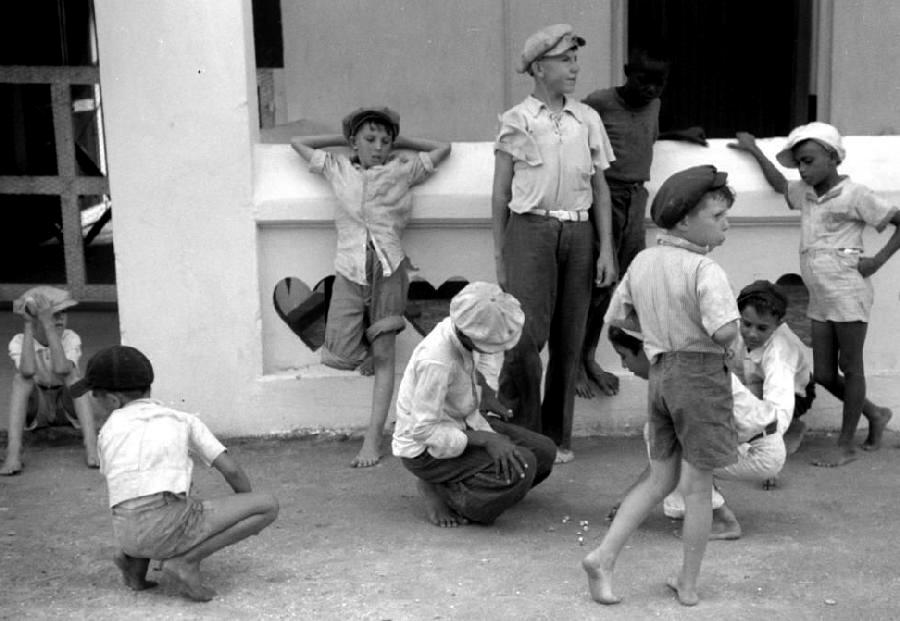
United States Regions: The Caribbean--The Virgin Islands

Figure 1.--There was a little settlement of French-speaking fishermens'on St. Thomas known as French Village. This photograph was taken during December 1941 in front of a general store. It shows French origin children and other mates playing marbles. We cannot see notable differences in their clothing. Source: Library of Congress LC-USF33-021358-M1.
|
|
The Virgin Islands are small islands located in the north of the Lesser Antilles, at the northeastern corner of the Caribbean island arc. They are some of the eastern or Leeward Islands. The Islands are an unincorporated territory of the United States. The major islands are St. Croix, St. John, and St. Thomas. The Virgin Passage separates the U.S. Virgin Islands from the "Passage Islands" or sometimes called the Spanish Virgin Islands (Vieques and Culebra). They are also U.S. territory but part of Puerto Rico. The location along the Anegada Passage means that they border a key shipping lane leadig to and from the Panama Canal. Charlotte Amalie on Saint Thomas is one of the best natural deepwater harbors in the Caribbean. Native American residents of the Virgin Islands included the Ciboney, Arawaks, and Caribs. Columbus sighted the Islands and was impressed with their beauty (1493). He named them the Virgins in honor of St. Ursula and her 11,000 virgins. The Native Americans cntibued to inhabit the Islands through much of the 16th century. Europeans reported the presene of Native Americans as late as 1585, but the islands were eventually abanonded. It is unclear just why, Slave raiders from nearby Puerto Rico may have been the reason. The French next acquired the Islands, but the Danish West Indian Company purchased St. Croix from the French (1733). The three islands became known as the Danish West Indies. The Virgin Islands archipelago were divided into two territorial units, one English and the other Danish (17th century). Sugarcane becane the main crop produced by slave labor The United States purchased the Danish Virgin Islands during World War I (1917). The primary interest was the defense of the Panama Canal and the possibility that Germny might invade Denmark or otherwise acquire the islands. The Danes insisted on payment in gold. The Danish West Indies thus became the U.S. Virgin Islands. The Islands have developed an economy based primarily on tourism. The Islands are seen as vacation paradises with beautuful white sand beaches and crystal clear water. Deep-sea fishing is a popular attraction.
Geography
The Virgin Islands are small islands located in the north of the Lesser Antilles, at the northeastern corner of the Caribbean island arc. They are some of the eastern or Leeward Islands. The Islands are an unincorporated territory of the United States. The major islands are St. Croix, St. John, and St. Thomas. The Virgin Passage separates the U.S. Virgin Islands from the "Passage Islands" or sometimes called the Spanish Virgin Islands (Vieques and Culebra). They are also U.S. territory but part of Puerto Rico. The location along the Anegada Passage means that they border a key shipping lane leadig to and from the Panama Canal. Charlotte Amalie on Saint Thomas is one of the best natural deepwater harbors in the Caribbean.
Columbus sighted the Islands and was impressed with their beauty (1493). He named them the Virgins in honor of St. Ursula and her 11,000 virgins. As with many small islands, the Spanish made no serious efforts to colonize the islands. Slave raiders from Puerto Rico made sweeps through the Islands. The French next acquired the Islands, but the Danish West Indian Company purchased St. Croix from the French (1733). The three islands became known as the Danish West Indies. The Virgin Islands archipelago were divided into two territorial units, one English and the other Danish (17th century). Sugarcane becane the main crop produced by slave labor The United States purchased the Danish Virgin Islands during World War I (1917). The primary American interest was the defense of the Panama Canal and the possibility that Germany might invade Denmark or otherwise acquire the islands. The Danes insisted on payment in gold. The Danish West Indies thus became the U.S. Virgin Islands.
Economy
The Islands have developed an economy based primarily on tourism. The Islands are seen as vacation paradises with beautuful white sand beaches and crystal clear water. Deep-sea fishing is a popular attraction.
Ethnicity
Native American residents of the Virgin Islands included the Ciboney, Arawaks, and Caribs. The Native Americans cntibued to inhabit the Islands through much of the 16th century. Europeans reported the presene of Native Americans as late as 1585, but the islands were eventually abanonded. It is unclear just why, Slave raiders from nearby Puerto Rico may have been the reason. The Islands became sugar islands and captive Africans were transported as sklaves to work the plantations
HBC

Navigate the Children in Hstory Website:
[Return to the Main Caribbean page]
[Return to the Main U.S. regional page]
[Return to the Main U.S. page]
[About Us]
[About Us]
[Introduction]
[Activities]
[Biographies]
[Chronology]
[Clothing styles]
[Countries]
[Girls]
[Theatricals]
[Topics]
[Bibliographies]
[Contributions]
[FAQs]
[Glossaries]
[Images]
[Links]
[Registration]
[Tools]
[Boys' Clothing Home]
Created: 8:08 PM 3/12/2012
Last updated: 5:53 PM 5/28/2018



